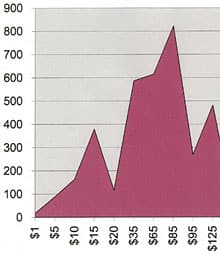The Price of Least Resistance – Business of Doing Business – The Journal of Antiques and Collectibles – July 2006
By Ed Welch
In 1962, I was a student at the University of Mainz at Gonsenheim, West Germany. I studied Western civilization, the German philosophers, American history (from a prospective not available here in the U.S.) and a business course called “Money.”
The course on money was, by far, the most interesting. The information I acquired has been financially rewarding. The course looked at the social, emotional and psychological aspects of spending money.
Spending money gives to the buyer absolute control and absolute power while making a purchase. Many compulsive buyers have little or no control over their domestic circumstances, working condition, spouses, relatives and so on. However, while he or she is spending money, the spender controls the entire process.
I could generate at least a dozen articles based on this one business course that I took 44 years ago. The urges and the drives that cause people to spend and sometimes save are the same now as then.
One part of that course is relevant to the antique trade. It would cost an antiques dealer zero dollars to implement some of the suggestion I will make.
The price of least resistance: gasoline is priced at $2.85.09 cents a gallon. A luxury automobile is priced at $29,999.95. It makes no difference that a $30,000 automobile cost only five cents more than the same automobile priced at $29,999.95. Psychologically there is a big difference between the number 29,000 and the number 30,000. Wal-Mart has done an excellent job convincing buyers that it always has the lowest prices. For many people, the lowest price is the price of least resistance. Of course, Wal-Mart’s claim of always having the lowest price is not entirely accurate. I buy an item of food that I use in my diabetic diet. The cost of this item of food is $1.50 less in Mooresville, North Carolina than Waterville, Maine.
When Wal-Mart opened a new Superstore in Waterville, the price of this item of food was more than at Hannaford’s and Shaw’s Supermarket, both located in Waterville. Because I purchase 150 to 200 of this item of food each year, and have done so for more than 10 years, a price difference of $1.50 per item equals a lot of money.
I am not a foe of Wal-Mart. I buy all my prescription drugs there, except one that I can buy at one-third the cost elsewhere. I buy clothing, gardening supplies, groceries and some automobile maintenance products. Wal-Mart’s somewhat lower prices are a plus for my family’s weekly expenses.
I prefer to think of the buying of the necessities of life and everyday living as a business endeavor. In fact, I refer to the process as, “the business of spending my money.” The better I handle the purchases of the necessities of everyday living, the more money I will have to buy antiques, help my children should they hit hard times and to splurge on things such as vacations. The necessities of everyday life – a home, automobile, clothing, food and other living expenses consume more than 80 percent of the weekly paycheck. Handling these expenses in a businesslike manner makes common sense.
I encourage dealers to take a course or two that covers the social, emotional, and psychological aspects of spending money. If you are not inclined to go back to school, buy and read a few books on the subject. If you discover nothing else, at least you be able to place yourself on the willingness to spend scale. Understanding why you spend money can help you understand why your customers spend money.
This knowledge will be a plus for you and your antiques business.
Some prices of high resistance have nothing to do with value and tend to be social in nature. In 1962, some American soldiers showed their disdain for Germany by using a Five Mark Note to light cigarettes and as toilet paper throwing the soiled note on the floor instead of in the flush. Remember, this was not long after WWII. Many buildings in Mainz were still hollow shells from bombing raids. In addition, a social taboo contributed further to the low regard for the Five Mark Note. The going rate for a prostitute in Germany was Five German Marks. Needless to say, many German merchants avoided pricing merchandise at Five Marks.
The chart that accompanies this article shows actual selling prices for the 65 types of antiques that I carry. The chart represents several years. I am not willing to give the exact number of years.
The side scale, 0 to 900, represents number of sales. The bottom scale, $1.00 to $125.00 is the actual selling price after the traditional 10 percent or so discount.
I maintain a similar chart for selling prices between $100.00 and $1,000.00. I also chart sales between $1,000.00 and $10,000.00. Only the $1.00 to $125.00 chart is considered in this article.
The first spike is at the $15.00 level. I have sold 379 items at this price. The second spike is at the $35.00 level. I have sold 587 items at this price. I have sold 615 items at the $65.00 level, 823 items at the $85.00 level and 482 items at the $125.00 level.
Notice the sharp drop in sales at the $20.00 level. I have had items in stock at the $20.00 selling price that have remained unsold for months. When I lowered the price of such items to $15.00, they sold immediately. This is the expected result from a lower selling price. However, I have raised the selling price to $35.00 and sold them immediately.
What is wrong with a $20.00 selling price? I am sure that a student attending a business school could offer several suggestions as to why $20.00 is a price of high resistance. The only light that I can shed on the subject is that as a child and young adult, I heard several adults utter something to the effect that, “I hate to break a $20.00 bill. As soon as you break a $20.00 bill, it is gone.”
I must admit that I hate to break a $20.00 bill to buy something small such as a cup of coffee. When I look in my wallet and see nothing but 20’s, I will shove my hand into my pocket to see if I have enough change to cover the purchased of the coffee.
$95 is also a price of high resistance. The same item priced at $85.00 will sell quickly. The prices $110.00, $115.00, and $120.00, are also prices of high resistance. If you have merchandise that will justify a price between $110 and $120, price that item at $138.00 and sell it for $125.00.
I am not certain why $95 is a price of high resistance. I believe that this price is too close to the $100 price. My personal selling experience has convinced me that the $100 price is a physical and psychological barrier that should be avoided. If you have any item worth around $100.00 and was able to purchase it at low cost, price that item at $85 for a quick sale or $125 for a sale that will require a bit more time.
I would like to end this article by expanding on the $85 selling price in more detail. Actually, I have nothing in my inventory priced to sell at $85. I discovered years ago that there is no difference between $85 and $86. Therefore, all items at this level are priced at $86. This may seem trivial but remember, I have sold 823 items at this price. In plain English, I have an extra $823 in my pocket with no expense or effort on my part. Adding one dollar did not work at any of the other price levels.
If you find an item that has a value of around $20.00 ask yourself, is the cost low enough to allow a resale price of $15.00. Is this item of high enough quality to bring $35.00? Use this same formula for all other prices of least resistance. If the item is not priced low enough to allow a profit at the low price, and if the item is not of high enough quality to justify the high price, do not buy it.
Your prices of least resistance may be different than mine. When I sold country furniture and accessories, I seldom had sales less than $65.00. Therefore, the $20.00 price of high resistance did not pertain to me, although the $95.00 price of high resistance tended to be a constant problem.
Review your sales records for the past couple of years. You are likely to find prices of high resistance and prices at which merchandise so marked sells quickly. Being aware of prices of high resistance can help you avoid buying merchandise that is hard to resell.
-
- Assign a menu in Theme Options > Menus WooCommerce not Found





Related posts: